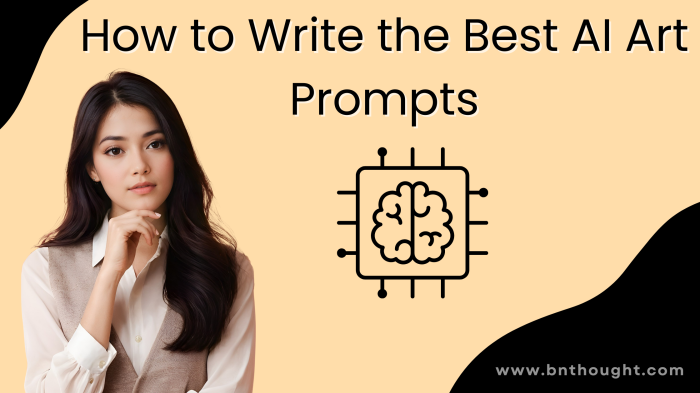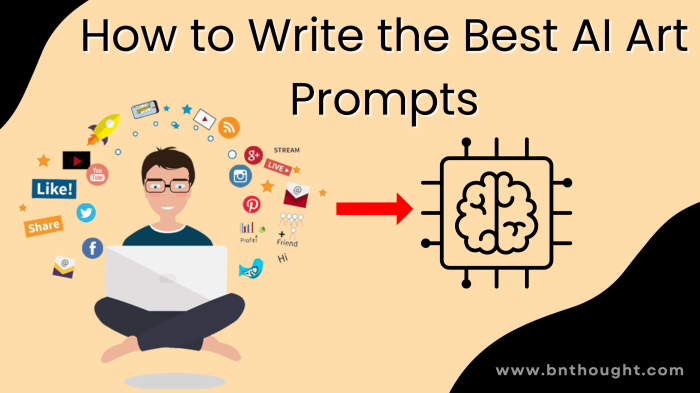
How to Write the Best AI Art Prompts
How to Write the Best AI Art Prompts. AI art prompts are a fascinating intersection of technology and creativity, providing a powerful tool for artists and enthusiasts alike. However, what exactly are they, and why might they say they are so critical?
1. What are AI Art Prompts?
AI art prompts are directives given to artificial intelligence systems designed to generate artistic content. These prompts can range from simple descriptions to complex narratives, guiding the AI to create unique and engaging pieces of art.
Importance of Crafting Effective AI Art Prompts
The quality of the art produced by AI largely depends on the quality of the prompts. Effective prompts can inspire stunning visuals, while poorly crafted ones may lead to uninspired or confusing results. Crafting the right prompts is crucial for unlocking the full potential of AI in art.
Purpose of the Article
This article aims to guide you through the process of writing the best AI art prompts. We’ll explore what makes a prompt effective, provide step-by-step instructions, and offer tips to help you master this skill.
2. Understanding AI Art Prompts
Before diving into the how-tos, let’s get a clear understanding of what AI art prompts are and the different types available.
Definition of AI Art Prompts
AI art prompts are specific instructions or ideas provided to an AI system, which it then uses to generate artwork. These can be textual descriptions, thematic concepts, or even emotional cues.
Types of AI Art Prompts
There are various types of AI art prompts, including:
- Descriptive Prompts: Detailed descriptions of scenes, objects, or characters.
- Thematic Prompts: Broad themes like “surrealism” or “futurism.”
- Emotional Prompts: Ideas based on emotions like “melancholy” or “joy.”
- Abstract Prompts: Vague or abstract concepts that challenge the AI to interpret creatively.
3. Why Write AI Art Prompts?
Creating AI art prompts isn’t just about getting the AI to produce art; it’s also about enhancing your own creativity and artistic skills.
Enhancing Creativity
AI art prompts can push you to think outside the box, inspiring new ideas and artistic directions you might not have considered otherwise.
Guiding AI Models
Clear and effective prompts guide AI models to produce better, more coherent artwork, making the AI a valuable tool in your creative process.
Improving Artistic Skills
Working with AI art prompts can help improve your descriptive and conceptual skills, as you learn to articulate your artistic visions more clearly.
4. Elements of a Good AI Art Prompt
Not all prompts are created equal. Here are the key elements that make an AI art prompt effective.
Clarity
A good prompt should be clear and easy to understand. Avoid ambiguous language that could confuse the AI.
Specificity
Specific details help the AI generate more accurate and engaging art. Rather than saying “a timberland,” say “a thick backwoods with transcending pine trees and a hazy climate.”
Creativity
Don’t be afraid to get creative with your prompts. Unique and imaginative prompts can lead to more interesting and original artwork.
Context
Providing context can help the AI better understand the prompt. For example, instead of just describing a character, include their background or the setting they’re in.
5. Step-by-Step Guide to Writing AI Art Prompts
Now, let’s dive into the step-by-step process of writing effective AI art prompts.
Step 1: Identify the Purpose
Figure out what you need to accomplish with the brief. Are you looking to create a specific scene, evoke a particular emotion, or explore a theme?
Step 2: Choose a Theme
Select a theme that interests you. This could be anything from fantasy landscapes to futuristic cities.
Step 3: Add Specific Details
Include specific details to guide the AI. The more vivid and precise your descriptions, the better the AI will be able to interpret them.
Step 4: Encourage Creativity
Challenge the AI with creative prompts. Instead of a simple “sunset,” try “a sunset over an alien planet with purple skies and floating islands.”
Step 5: Review and Revise
After writing your prompt, review it for clarity and detail. Revise as needed to ensure it’s as effective as possible.
6. Common Mistakes to Avoid
Even with the best intentions, it’s easy to make mistakes when writing AI art prompts. Here are a few normal entanglements to look out for.
Vague Descriptions
Avoid vague descriptions that leave too much to the AI’s interpretation. Be basically as unambiguous as conceivable to obtain the ideal outcomes.
Overcomplicating Prompts
While details are important, overcomplicating prompts with too many elements can confuse the AI. Keep it balanced.
Ignoring Audience
Consider who will be viewing the art. Tailor your prompts to suit the intended audience, whether it’s for a general audience or a specific group of enthusiasts.
7. Examples of Effective AI Art Prompts
Here are some examples of well-crafted AI art prompts to inspire you.
Fantasy Themes
“A majestic dragon flying over a medieval castle at sunset.”
“An enchanted forest with glowing flowers and mythical creatures.”
Realistic Scenarios
“A bustling city street during a rainy night, with reflections of neon lights on the wet pavement.”
“A peaceful field with moving slopes, nibbling sheep, and a comfortable house.”
Abstract Concepts
“A surreal dreamscape with floating clocks and melting mountains.”
“A hypothetical depiction of the impression of contemplation.”
Emotional Expressions
“A lonely figure standing on a cliff, overlooking a stormy sea, conveying a sense of isolation.”
“A joyful celebration with people dancing under colorful fireworks.”

8. How to Test Your AI Art Prompts
Testing your prompts ensures they produce the desired results. Here’s how you can do it.
Using AI Tools
Use AI art generators to test your prompts. Adjust as needed based on the results to fine-tune your prompts.
Getting Feedback from Artists
Share your prompts with artists and get their feedback. They can provide insights on how to improve your prompts for better artistic outcomes.
9. Tools and Resources for AI Art Prompts
There are numerous tools and resources available to help you craft and test your AI art prompts.
AI Art Generators
Tools like DALL-E, MidJourney, and Artbreeder can generate art based on your prompts.
Online Communities
Join communities like AI Art forums and social media groups where you can share prompts and get feedback.
Educational Resources
Books, courses, and tutorials on AI and art can provide valuable insights and inspiration.
10. Advanced Tips for Mastering AI Art Prompts
Once you’ve mastered the basics, here are some advanced tips to take your AI art prompts to the next level.
Combining Different Themes
Experiment with combining different themes to create unique and unexpected results.
Pushing Creative Boundaries
Challenge yourself and the AI by pushing creative boundaries. Try prompts that defy conventional artistic norms.
Experimenting with Styles
Explore different artistic styles and see how the AI interprets them. This can lead to discovering new artistic directions.
11. The Future of AI Art Prompts
The field of AI art prompts is constantly evolving. Here’s what the future might hold.
Emerging Trends
Stay updated with the latest trends in AI art to keep your prompts relevant and innovative.
Potential Developments
Advancements in AI technology will continue to enhance the capabilities of AI art generators, offering even more creative possibilities.
How To Make An AI on Your Computer. Read More... Conclusion
Recap of Key Points
We’ve explored what AI art prompts are, why they’re important, and how to craft them effectively. By understanding the key elements and following a structured approach, you can unlock the full potential of AI in art.

